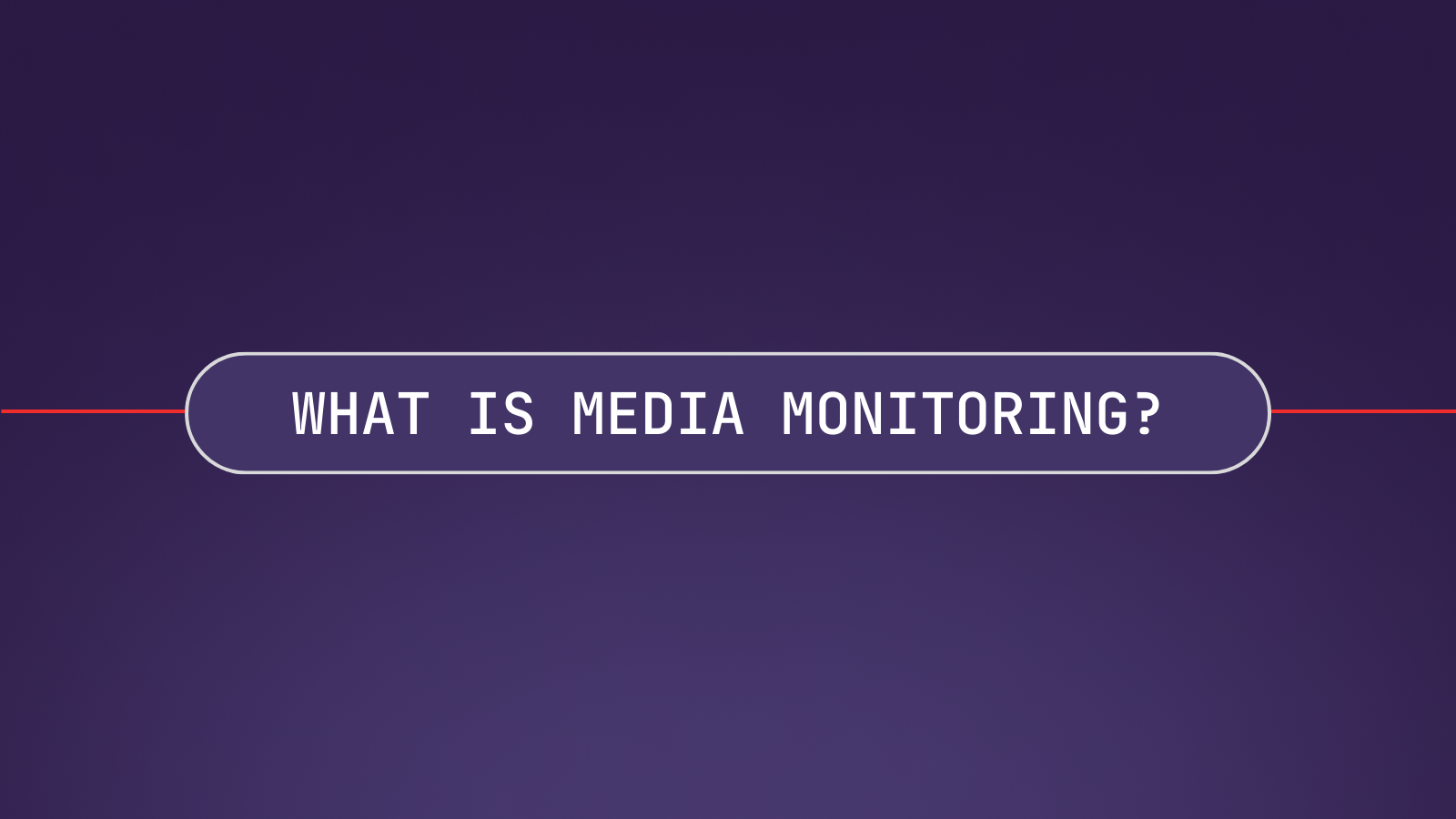With so much information available online, it’s never been easier for consumers to make quick decisions about your brand. Consequently, it's never been more critical to keep tabs on your brand's presence with media monitoring.
Patrolling the endless sea of digital news can feel overwhelming, especially when it's tucked behind videos, podcasts, and livestreams. Fortunately, as the sea grows larger and more complex, so do the tools at your disposal.
Media monitoring doesn't have to be tedious guesswork and estimations. With the right cutting-edge tools and technology, you can more quickly and accurately track and analyze your brand's digital presence.
Below, we'll walk you through the ins and outs of media monitoring, highlighting its significance (and benefits) and exploring how AI can supercharge your efforts.
What Is Media Monitoring?
Media monitoring is the process of tracking, collecting, and analyzing mentions of brands, topics, or keywords across platforms. Traditionally, this included newspapers, magazines, TV broadcasts, and radio, but it's now expanded to digital media sources:
- Social media networks
- Online news sites
- Blogs
- Forums
- Video
- Podcasts
- TV
The purpose of media monitoring is to stay up to date on how the public perceives your brand. Your goal isn't just to find mentions—it's to interpret the context, sentiment, and potential impact those mentions have. Armed with that information, you'll be better prepared to influence your media presence in the right direction.
Some brands approach media monitoring with rudimentary techniques, manually tracking mentions through individual platform features and human resources, a time-consuming task. Other brands use smart media monitoring software solutions to scan the vast expanses of the internet more efficiently and accurately.
For example, businesses use AssemblyAI’s AI models to target and analyze media content across podcasts, video, TV, and radio, automatically finding mentions and detecting context and sentiment.
Why Is Media Monitoring Important?
Words matter, and in today's interconnected and fast-paced digital world, they travel faster than the speed of sound. Every conversation has the chance to help or hurt your brand, but you won't know the impact (or have the opportunity to influence it) without media monitoring.
Consider media monitoring your digital eyes and ears. Media monitoring ensures your brand evolves from reactive to proactive, anticipating threats and opportunities before they arrive at your public relations team's doorstep.
Here are a handful of reasons media monitoring is a must-have for modern brands:
- Reputation management: Trust takes years to build and seconds to break. Media monitoring proactively identifies positive and negative narratives, giving your brand time to respond before it's too late.
- Competitive analysis: Media monitoring lets you keep tabs on your competitors, gauge their media presence, and make strategic decisions based on that real-time data.
- Audience sentiment: Advanced monitoring tools help you gain deeper insights into public opinion beyond mentions and shares. You can see whether comments were positive, negative, or neutral.
- Crisis control: Not all publicity is good publicity. When negative press issues arise, media monitoring alerts let you follow conversations in real-time and deploy quick and effective crisis management strategies.
- Marketing ROI: Learn how your campaigns and marketing strategies perform in the digital landscape by tying engagement to specific mentions and activities.
- Strategic planning: Explore how your brand and products are perceived to better inform your marketing campaigns, product development, and public relations campaigns.
- Influencer monitoring: Discover influencers or micro-influencers already discussing your brand to explore partnerships.
Benefits of AI for Media Monitoring
With consumers, companies, and influencers publishing millions of posts and videos daily, tracking and analyzing all the content is impossible without a bit of help. Rapidly evolving AI tools provide game-changing solutions at scale, allowing businesses (big and small) to scan the vast digital world.
Here's how brands can leverage AI to supercharge their media monitoring activities:
- Speech and video recognition: AI models can process and transcribe video and audio content. State-of-the-art models also deliver more than just speech-to-text capabilities, including sentiment analysis, topic detection, and more. This broadens the spectrum of media monitoring to include podcasts, videos, radio, and broadcasts.
- Sentiment analysis: AI models can interpret the sentiment behind mentions, giving your brand an in-depth understanding of the conversations' context and feelings.
- Automated content scanning: Data creation never sleeps, but your employees do. AI-powered tools continuously scan extensive amounts of data across various platforms, ensuring no mention or relevant content is missed.
- Real-time analysis: AI tools can instantly analyze and categorize content, allowing brands to respond quickly to emerging trends, crises, or opportunities.
- Content moderation: Detect sensitive content (hate speech, violence, alcohol, drugs, social issues, and more) that demands an immediate response with AI content moderation.
- Summarization: You don't have time to listen to entire podcasts or videos, but AI does. AI summarization models can automatically summarize conversations behind audio and video files to give you additional context behind mentions and important phrases.
How to Choose the Right AI Partner
For better or worse, you have plenty of options when it comes to selecting an AI partner for media monitoring. It’s a fast-evolving solution that’s growing in capabilities and scale.
However, not all solutions are created equally. Choosing the right AI partner for media monitoring can make the difference between obtaining actionable insights and drowning in irrelevant data. Here are some things to look for during the buying process:
- Ease of use: Look for simple-to-use APIs that let you complete a variety of tasks, such as transcribing, synthesizing, extracting, and organizing information.
- Scalability: Determine the volume of media you need to monitor. Do you need a solution tailored for large-scale, global monitoring or a more localized approach?
- Features: Think about the must-have features. These could be timestamps, speaker labels, automatic punctuation and casing, international language support, custom vocabulary, profanity filtering, and filler word omissions.
- Media types: Think about the media types you want to monitor. Simple AI partners might only analyze print, web content, and social media, but you might want podcasts, videos, and broadcasts.
- Accuracy: Look for an AI tool that has top-notch precision and accuracy. Beyond identifying mentions, it should be able to reliably categorize information and determine the sentiment.
- Real-time analysis: Timing is everything. Look for an AI solution that can provide real-time insights and alerts.
- Languages: If your brand has a global footprint, you’ll want to use an AI partner that can monitor and analyze media in multiple languages and understand cultural contexts.
- Future-proofing: The AI landscape is dynamic and quickly evolving. Partner with a company that’s committed to continuous research and development, ensuring your media monitoring remains relevant and effective.
AssemblyAI’s AI models for media monitoring check all the boxes. You can use our AI models to achieve industry-leading transcription accuracy (>90%) through a simple API. Our Conformer-2 speech recognition model was trained on 1.1M hours of training data and can perform state-of-the-art speech recognition in over 17 languages.
Get Started With Smart Media Monitoring
As your customers continue to take their relationships, conversations, reviews, and news digestion online, getting a pulse on the situation is critical to engage proactively.
Fortunately, it's easier than ever to track and analyze mentions on the internet—even across voice and video.
AssemblyAI's simple API can transcribe and analyze data across countless media sources. Our superhuman AI models provide state-of-the-art asynchronous and real-time speech recognition, entity detection, content summarization, topic detection, content moderation, and more. You don't just get the volume count of brand mentions (though you get that, too)—you get share of voice, sentiment analysis, and contextual analysis.







